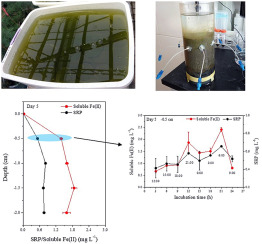Water Research ( IF 11.4 ) Pub Date : 2018-01-18 , DOI: 10.1016/j.watres.2018.01.040 Musong Chen , Shiming Ding , Xiang Chen , Qin Sun , Xianfang Fan , Juan Lin , Mingyi Ren , Liyuan Yang , Chaosheng Zhang

|
Algal growth causes a drastic change in aquatic conditions over a diel cycle, which may induce sensitive feedback systems in sediments, causing P release. In this study, a microcosm experiment was performed using a suction sampler (Rhizon) to observe changes in soluble reactive phosphorus (SRP) and soluble Fe(II) concentrations in the top 20 mm sediment layer on a 3-h time interval, at different phases of harmful algal bloom (HAB) development. The results showed that the algal blooms prevailed up to 15 days after incubation, after which the process of bloom collapse proceeded until the 70th day. The concentrations of pore-water soluble Fe(II) and SRP increased throughout the incubation period. Compared to day 1, maximum increases of 214% in soluble Fe(II) and 387% in SRP were observed at night during the bloom and collapse periods, respectively. The diffusive fluxes of Fe and P at the sediment-water interface (SWI) generally corresponded to their changes in concentrations. Hourly fluctuation in soluble Fe(II) and SRP concentrations were observed with two distinct concentration peaks occurred at 21:00 p.m. and 06:00 a.m. (or 03:00 a.m.), respectively. These findings suggest that Fe-P coupling mechanisms are responsible for the release of P from sediments. During the collapse period, soluble Fe(II) concentrations were suppressed by the increase of labile S(-II) at night. Meanwhile, SRP concentrations were decoupled from Fe cycling with small fluctuations (<11% RSD) on an hourly timescale, and the decomposition of algae was a dominant source contributing to the release of P from sediments. These results significantly improved the understanding of processes and mechanisms behind the stimulated release of P from sediments during HABs.
中文翻译:

基于沉积物中铁和磷浓度的每小时变化来驱动藻华期间磷释放的机制
藻类的生长会在diel周期内导致水生条件发生剧烈变化,这可能会在沉积物中引起敏感的反馈系统,从而导致P的释放。在这项研究中,使用吸气采样器(Rhizon)进行了缩影实验,观察了在3小时的时间间隔内,不同时间的20毫米顶部沉积层中可溶性反应性磷(SRP)和可溶性Fe(II)浓度的变化。有害藻华(HAB)发育的各个阶段。结果表明,在孵化后的15天之内藻类水华盛行,此后水华崩溃过程一直持续到第70天。在整个孵育过程中,孔水溶性Fe(II)和SRP的浓度增加。与第1天相比,在开花和倒塌期间的晚上,分别观察到可溶性Fe(II)和SRP的最大增加分别为214%和387%。Fe和P在沉积物-水界面(SWI)的扩散通量通常与其浓度变化相对应。观察到可溶性Fe(II)和SRP浓度每小时波动,分别在21:00 pm和06:00 am(或03:00 am)出现两个明显的浓度峰。这些发现表明,Fe-P耦合机制是导致P从沉积物中释放的原因。在崩塌期间,夜间不稳定的S(-II)的增加抑制了可溶性Fe(II)的浓度。同时,SRP浓度在一个小时的时间尺度上与Fe循环解耦,且波动很小(<11%RSD),藻类的分解是导致P从沉积物中释放的主要来源。











































 京公网安备 11010802027423号
京公网安备 11010802027423号